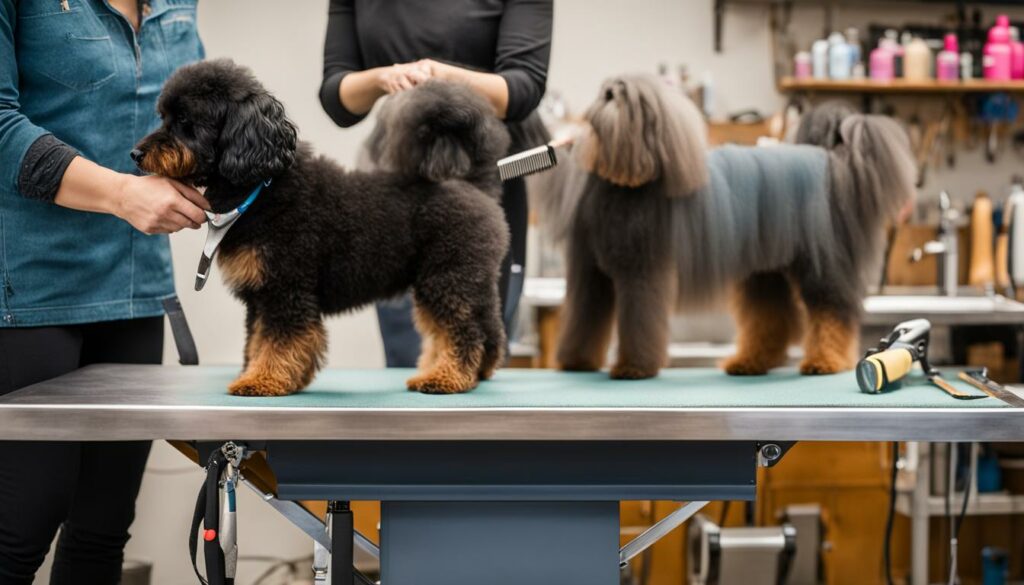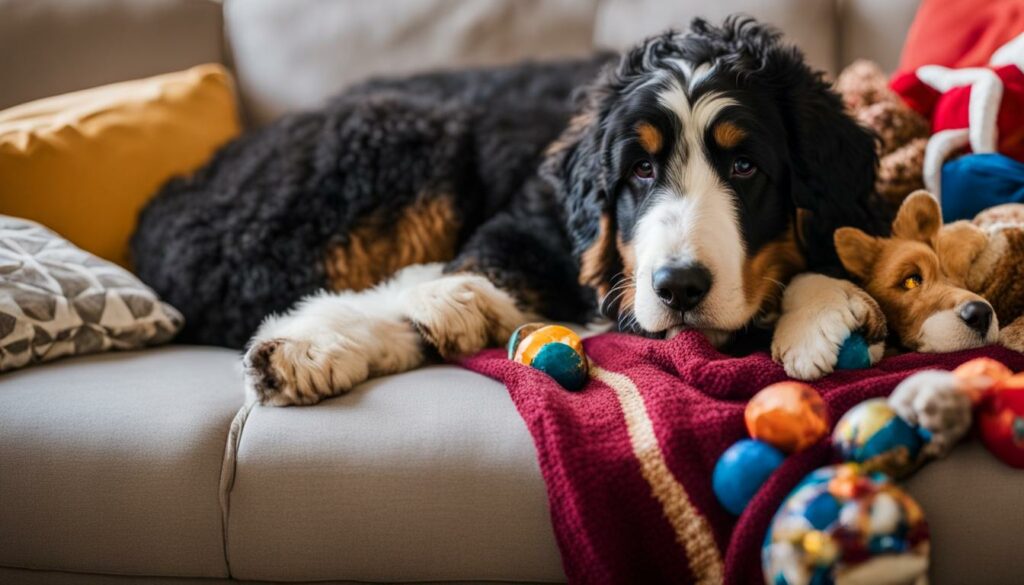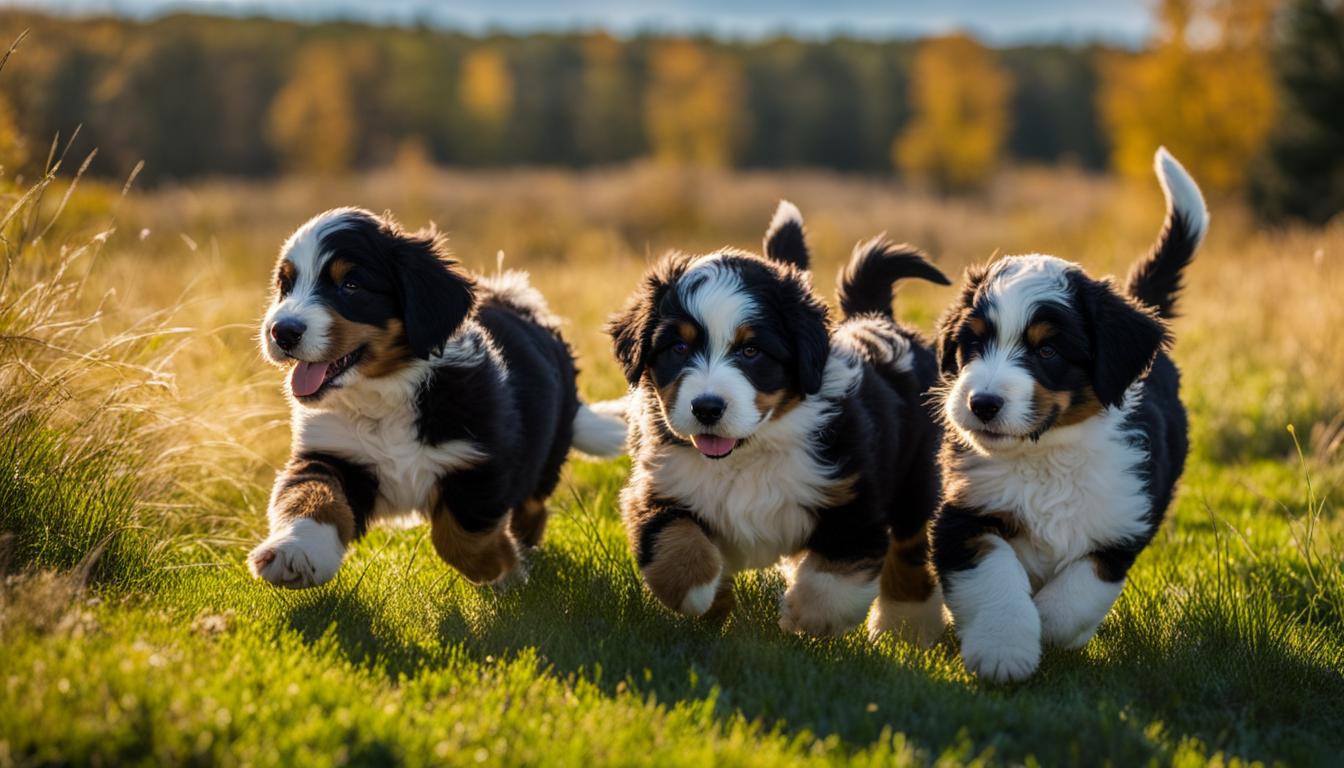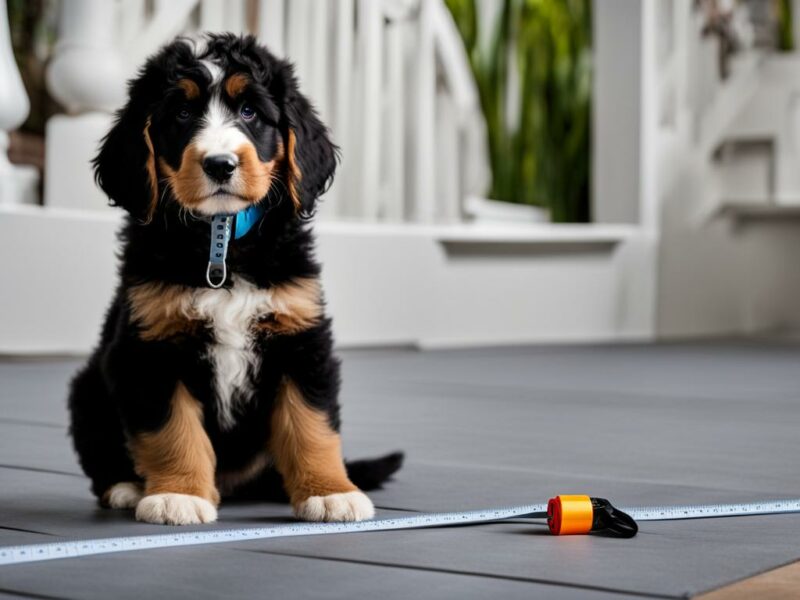Hi there! Welcome to my comprehensive guide on Bernedoodles, the charming crossbreed between a Bernese Mountain Dog and a Poodle. If you’ve ever come across this adorable breed or are considering adding a Bernedoodle to your family, you’re in for a treat! In this article, I will walk you through everything you need to know about Bernedoodles, from their origin and development to their size, temperament, grooming needs, and coat colors.
Bernedoodles have quickly gained popularity due to their cuddly nature and lovable personalities, making them the perfect companion for families and individuals alike. They inherit the best traits from their parent breeds, combining the gentle and friendly nature of the Bernese Mountain Dog with the intelligence and low-shedding coat of the Poodle.
Now, let’s delve into the fascinating world of Bernedoodles and discover all there is to know about these delightful crossbreeds. Whether you’re curious about their size and temperament, interested in their grooming needs, or simply want to marvel at their beautiful coat colors, this guide has got you covered!
Key Takeaways:
- Bernedoodles are a crossbreed between a Bernese Mountain Dog and a Poodle, known for their charm and cuddly nature.
- They make excellent family pets, combining the gentle nature of the Bernese Mountain Dog with the intelligence of the Poodle.
- Bernedoodles come in a range of sizes, from tiny to standard, to fit different living situations.
- Their coat requires regular grooming to keep it clean and tidy, with different colors and types available.
- While Bernedoodles have their advantages, it’s important to consider their exercise and grooming needs before bringing one home.
The Origin and Development of Bernedoodles
The Bernedoodle is a relatively new hybrid breed that was first developed in the early 2000s. The breed was created by crossing a Bernese Mountain Dog with a Poodle to combine the desirable traits of both breeds. The goal was to create a family-friendly dog with the intelligence and low-shedding coat of a Poodle and the gentle and friendly nature of a Bernese Mountain Dog. Since then, Bernedoodles have gained popularity for their charming personality and adorable appearance.
Decoding the Bernedoodle Generations: F1, F1B, F2, and Beyond
Bernedoodles are classified into different generations based on their parentage. Each generation has its own unique characteristics and traits. Let’s explore the various Bernedoodle generations:
What is an F1 Bernedoodle?
An F1 Bernedoodle is a first-generation cross between a Bernese Mountain Dog and a Poodle. This pairing results in a Bernedoodle with a 50% Bernese Mountain Dog genetic makeup and a 50% Poodle genetic makeup. F1 Bernedoodles inherit traits from both parent breeds, combining the Bernese Mountain Dog’s gentle nature with the Poodle’s intelligence and low-shedding coat.
Understanding the F1B Bernedoodle: A Closer Look
An F1B Bernedoodle is a backcross between an F1 Bernedoodle and a Poodle. This generation aims to increase the Poodle’s influence in the genetic makeup of the Bernedoodle. As a result, F1B Bernedoodles typically have a higher percentage of Poodle genes than F1 Bernedoodles. The increased Poodle influence often leads to a curlier and lower-shedding coat.
Breaking Down the F2 Bernedoodle Genetics
An F2 Bernedoodle is a second-generation cross between two F1 Bernedoodles. In this generation, the genetic makeup is a combination of F1 Bernedoodle genes. While F2 Bernedoodles can inherit different traits from their F1 parents, they generally have a similar appearance and temperament. The coat type and shedding tendencies may vary within the F2 generation.
Understanding the different Bernedoodle generations can provide valuable insights into the expected traits and characteristics of these crossbreeds. Whether you’re drawn to the first-generation F1 Bernedoodle or prefer the increased Poodle influence in an F1B Bernedoodle, each generation offers its own adorable and lovable qualities.
Bernedoodles: A Perfect Blend of Size and Temperament
Bernedoodles are a crossbreed known for their unique combination of size and temperament. Whether you’re looking for a compact companion or a larger family pet, Bernedoodles come in a range of sizes to accommodate different living situations. Despite their size differences, these charming dogs share similar temperaments that make them a popular choice among dog lovers.
Comparing Bernedoodle Sizes: Tiny to Standard
When it comes to Bernedoodle sizes, there are three main categories:
- Tiny Bernedoodles: These adorable pups usually weigh between 15-30 pounds. They are the smallest of the Bernedoodle sizes and are perfect for individuals or families in smaller living spaces.
- Mini Bernedoodles: The middle-sized Bernedoodles, Mini Bernedoodles typically weigh approximately 35-50 pounds. They are a great choice for families who want a slightly larger dog without the size of a Standard Bernedoodle.
- Standard Bernedoodles: The largest of the Bernedoodle sizes, Standard Bernedoodles weigh 55 pounds or more. They are a popular choice for families with larger homes and outdoor spaces.
Choosing the right size of Bernedoodle depends on your preferences, living situation, and ability to care for a larger or smaller dog. All Bernedoodle sizes share the same lovable personality that makes this breed truly special.
Temperament Traits: The Best of Both Worlds
The temperament of Bernedoodles is a delightful blend of the gentle and friendly nature of the Bernese Mountain Dog and the intelligence and trainability of the Poodle. These charming dogs are known for their:
- Loving and Affectionate Nature: Bernedoodles are devoted companions who form strong bonds with their owners. They thrive on human companionship and enjoy being part of a family.
- Gentle and Patient Demeanor: Bernedoodles have a naturally calm and patient temperament, making them great with children and other pets. They are usually very tolerant and easygoing.
- Intelligence and Trainability: These dogs are highly intelligent and eager to please. They are quick learners and respond well to positive reinforcement training methods.
The distinctive combination of size and temperament makes Bernedoodles an excellent choice for families, individuals, and anyone looking for a loyal and loving companion.
Bernedoodle Grooming Essentials: Keeping Your Doodle Tidy
Proper grooming is essential to keep your Bernedoodle looking and feeling their best. Their unique coat requires regular care and attention to maintain its health and appearance. Whether your Bernedoodle has a curly or straight coat, it’s important to establish a grooming routine to prevent matting and ensure their coat stays clean and tidy.
One of the key aspects of Bernedoodle grooming is regular brushing. Brushing helps remove loose hair and prevents tangling and matting. The frequency of brushing depends on the length and texture of your Bernedoodle’s coat. Curly-coated Bernedoodles may require more frequent brushing to prevent matting, while those with straight coats may need less frequent brushing.
In addition to brushing, bathing your Bernedoodle is another important part of their grooming routine. The frequency of baths depends on your Bernedoodle’s activity level, coat condition, and personal preference. Generally, bathing every 4-6 weeks is sufficient for most Bernedoodles. Use a dog-specific shampoo and conditioner to keep their coat clean and moisturized.
To keep your Bernedoodle’s coat in optimal condition, professional grooming may be necessary. Professional groomers have the expertise and tools to ensure your Bernedoodle’s coat is well-maintained and styled. They can trim the coat, clip the nails, clean the ears, and perform other grooming tasks that require specialized skills.
Finally, it’s important to pay attention to your Bernedoodle’s overall well-being during grooming sessions. Look out for any signs of discomfort or stress and take breaks if needed. Use positive reinforcement and rewards to make grooming a positive experience for your Bernedoodle.

Grooming your Bernedoodle is not only about maintaining their appearance but also their health and hygiene. By providing regular care and attention, you can ensure that your Bernedoodle remains clean, comfortable, and looking their best.
The Designer Appeal: Bernedoodle Colors and Coats
Bernedoodles are not only adored for their charming personality and friendly nature but also for their stunning coat colors and types. In this section, we will explore the wide range of colors and coat types that Bernedoodles can exhibit, allowing you to find the perfect furry friend with the coat that catches your eye.
Deciphering the Palette: Traditional and Rare Colors
Bernedoodles come in a variety of colors, ranging from traditional to rare hues. The most common colors include black, white, and various shades of brown, resembling the signature markings of the Bernese Mountain Dog. These classic colors are beloved by many Bernedoodle enthusiasts and are a testament to the breed’s heritage.
“The traditional coat colors of Bernedoodles reflect the distinctive markings of their Bernese Mountain Dog parent.”
In addition to the traditional colors, Bernedoodles can also exhibit rare and unique coat colors. These can include tri-colors, parti-colors, and even merle patterns, which add an extra flair to their already captivating appearance. Keep in mind that rare colors may be more challenging to find, but they can make your Bernedoodle truly one-of-a-kind.
Coat Types: Curly, Wavy, and Straight Explained
Aside from the exciting array of colors, Bernedoodles can have different coat types, each with its own unique characteristics and grooming requirements. The three main coat types found in Bernedoodles are:
- Curly: Curly-coated Bernedoodles have tight, spiral-like curls that often resemble the Poodle parent’s coat. This type of coat is usually low-shedding and requires regular grooming to prevent matting.
- Wavy: Wavy-coated Bernedoodles have looser waves in their fur, offering a balance between the tight curls and straight coat types. Wavy coats typically have minimal shedding and are relatively easy to maintain.
- Straight: Straight-coated Bernedoodles have a sleek, straight coat that may have a slight wave or no wave at all. This coat type may require less grooming and sheds more moderately compared to curly or wavy coats.
| Coat Type | Description | Grooming Needs |
|---|---|---|
| Curly | Tightly curled, resembling Poodle parent | Regular grooming to prevent matting |
| Wavy | Loose waves, balanced between curly and straight | Minimal shedding, relatively easy to maintain |
| Straight | Sleek and straight, may have a slight wave | Less grooming, moderate shedding |
Understanding the different coat types will not only help you choose a Bernedoodle that matches your desired aesthetic but also guide you in providing the appropriate care and maintenance for their specific coat type.
Choosing Your Companion: Pros and Cons of Owning a Bernedoodle
While owning a Bernedoodle can be a rewarding experience, it’s essential to consider the pros and cons before making a decision. Whether you’re a first-time dog owner or have had pets before, understanding the benefits and challenges of owning a Bernedoodle will help you determine if this lovable breed is the right fit for you and your lifestyle.
Pros of Owning a Bernedoodle
There are several reasons why Bernedoodles are cherished companions:
- Friendly and Gentle Nature: Bernedoodles are known for their friendly and gentle temperament, making them excellent family pets.
- Intelligence: These crossbreeds inherit the intelligence and trainability of their Poodle parent, making them quick learners.
- Low-Shedding Coat: Bernedoodles often have a low-shedding or hypoallergenic coat, which can be beneficial for individuals with allergies.
Cons of Owning a Bernedoodle
Despite their many positives, Bernedoodles also come with some challenges:
- Exercise Requirements: Bernedoodles are an active breed and require regular exercise to keep them physically and mentally stimulated.
- Grooming Needs: Depending on their coat type, Bernedoodles may require regular grooming to prevent matting and keep their coat in good condition.
By carefully weighing the pros and cons, you can make an informed decision about whether a Bernedoodle is the right companion for you and your family.
“Owning a Bernedoodle comes with its own set of benefits and challenges. Considering these factors will help you build a strong and lasting relationship with your furry friend.”
– Anonymous Bernedoodle Owner

| Pros of Owning a Bernedoodle | Cons of Owning a Bernedoodle |
|---|---|
| Friendly and Gentle Nature | Exercise Requirements |
| Intelligence | Grooming Needs |
| Low-Shedding Coat |
Navigating Bernedoodle Health: Essential Medical Considerations
Like all dog breeds, Bernedoodles may be prone to certain health issues. It’s essential to be aware of these potential health concerns and take proper measures to keep your Bernedoodle healthy.
Common health issues in Bernedoodles may include hip dysplasia, eye problems, and certain genetic conditions. Regular veterinary check-ups, a balanced diet, exercise, and proper grooming are important for maintaining your Bernedoodle’s overall health and well-being.
The Heart of the Home: Bernedoodles as Family Pets
Building Strong Bonds: Bernedoodle Loyalty and Attachment
Bernedoodles are known for their loving and affectionate nature, making them excellent family pets. They have an innate ability to form strong bonds with their owners, bringing a sense of warmth and companionship to the household. Their loyalty is unmatched, and they will go above and beyond to protect and adore their human family members. Whether it’s cuddling on the couch, joining in on family activities, or simply being a constant source of emotional support, Bernedoodles bring immense joy and love to every family they become a part of. Their devotion is unwavering, making them the heart of the home.
Socializing Your Bernedoodle for a Friendly Disposition
Socialization is crucial for ensuring that your Bernedoodle develops a friendly and confident disposition. Early socialization exposes them to different people, animals, sights, and sounds, helping them become well-rounded and adaptable to various situations. By introducing your Bernedoodle to new experiences in a positive and controlled manner, you can help them grow into a well-behaved and sociable companion. This includes regular interactions with family members, friends, other pets, and exposure to different environments. Socialization not only aids in their emotional well-being but also promotes a harmonious coexistence with other members of their extended family.
Distinguishing Bernedoodles from Other ‘Doodle’ Breeds
While Bernedoodles belong to the ‘Doodle’ family of dog breeds, they have their own unique characteristics and traits that distinguish them from other Doodle breeds. Although they share some similarities, such as low-shedding coats and intelligence, Bernedoodles stand out with their larger size, striking tri-color markings, and gentle nature. They inherit the best qualities of both Bernese Mountain Dogs and Poodles, resulting in a breed that is well-suited for families and individuals seeking a loyal, affectionate, and intelligent companion. Their exceptional temperament, stunning appearance, and versatile nature make Bernedoodles a top choice for those looking to add a loving and cherished member to their family.
| Bernedoodle Loyalty | Bernedoodle Socialization | Bernedoodle vs Other Doodle Breeds |
|---|---|---|
| Known for their loving and devoted nature | Building strong bonds through early socialization | Distinguished by their larger size, tri-color markings, and gentle temperament |
| Form deep attachments to their owners and families | Exposure to different people, animals, and environments for a friendly disposition | Combination of Bernese Mountain Dog and Poodle traits |
| Provide unwavering loyalty and emotional support | Positive interactions with family, friends, and other pets | Loving and intelligent breed suitable for families |
Training and Educating Your Bernedoodle: The Path to Obedience
Training and educating your Bernedoodle is essential for their development and well-being. Bernedoodles are intelligent and eager to please, making them highly trainable and responsive to positive reinforcement methods.
Basic obedience training is an important foundation for your Bernedoodle’s behavior. Teach them essential commands such as sit, stay, down, and come. Use treats or toys as rewards and praise them for their successes. Consistency is key in training, so establish a regular training schedule and stick to it.
Socialization is another crucial aspect of your Bernedoodle’s education. Expose them to different environments, people, and animals from an early age. This will help them become well-adjusted and confident in various situations. Gradually increase the level of difficulty in socialization exercises to ensure continued growth.
In addition to obedience training and socialization, mental stimulation is vital for your Bernedoodle’s overall well-being. Engage them in activities that challenge their minds, such as puzzle toys, interactive games, and obedience trials. This will prevent boredom and channel their energy into productive and positive outlets.
When training your Bernedoodle, remember to be patient and use positive reinforcement techniques. Punishment or harsh methods can be counterproductive and may lead to anxiety or fearfulness. Instead, focus on rewarding good behavior with treats, praise, and affection. This will strengthen the bond between you and your Bernedoodle and create a positive learning environment.
By investing time and effort into training and educating your Bernedoodle, you will help them become a well-behaved and well-adjusted member of your family. The path to obedience may have its challenges, but with consistency, patience, and positive reinforcement, you can guide your Bernedoodle towards becoming a loving and obedient companion.
Adoption and Breeding Ethics: Finding a Responsible Bernedoodle Breeder
The Importance of Ethical Breeding Practices
If you decide to adopt a Bernedoodle, it’s crucial to find a responsible and reputable breeder who upholds ethical breeding practices. Ethical breeding prioritizes the health, well-being, and quality of life for the dogs involved, ensuring they are treated with care and respect throughout their lives.
Responsible Bernedoodle breeders focus on the following ethical practices:
- Thorough health testing: Ethical breeders prioritize the health of their breeding dogs and ensure they are free from genetic disorders and hereditary conditions that can be passed onto their puppies.
- Proper socialization: Ethical breeders invest time and effort in socializing the puppies from an early age, exposing them to different environments, people, and experiences to promote their overall well-being and confident temperament.
- Transparent breeding practices: Ethical breeders are transparent about their breeding program, providing information about the parent dogs’ health, pedigrees, and any relevant certifications or awards.
- Continued care and support: Responsible breeders offer ongoing support and guidance to adopters, ensuring a smooth transition for the puppies into their new homes and providing assistance whenever needed.
By choosing a breeder who follows ethical practices, you contribute to the overall well-being and improvement of the Bernedoodle breed, promoting healthier and happier dogs.
How to Identify a Reputable Bernedoodle Breeder
When searching for a Bernedoodle breeder, there are certain factors to consider to ensure you find a reputable and trustworthy breeder:
- Research extensively: Take the time to research and gather information about different breeders in your area. Look for reviews, testimonials, and recommendations from past adopters.
- Visit the breeder’s facilities: Arrange a visit to the breeder’s facilities to see how the dogs are raised and cared for. A responsible breeder will have clean and well-maintained facilities with a nurturing environment for their dogs and puppies.
- Ask about health certifications: Inquire about health testing performed on the parent dogs and ask to see the relevant certifications. A reputable breeder will readily provide this information to ensure that their breeding dogs are free from common hereditary health issues.
- Meet the parent dogs: If possible, meet the parent dogs to assess their temperament, behavior, and overall health. This will give you an idea of the traits and characteristics your Bernedoodle puppy may inherit.
- Interview the breeder: Ask the breeder comprehensive questions about their breeding program, their breeding dogs, socialization practices, and any guarantees or after-purchase support they offer. A responsible breeder will be knowledgeable, honest, and open to answering your queries.
By conducting thorough research, visiting the facilities, and asking the right questions, you can identify a reputable Bernedoodle breeder who genuinely cares about the well-being of their dogs and the future happiness of the puppies they produce.
Conclusion
Bernedoodles are a beloved crossbreed that embodies the best qualities of both Bernese Mountain Dogs and Poodles. With their charming personality, adorable appearance, and family-friendly nature, Bernedoodles make wonderful companions for individuals and families alike. Whether you’re seeking a cuddly pet or a loyal friend, Bernedoodles are guaranteed to steal your heart.
By understanding the origin and development of Bernedoodles, the different generations, sizes, temperaments, grooming needs, and coat colors, you can make an informed decision about welcoming a Bernedoodle into your home. These delightful dogs are known for their lovable and loyal nature, making them a perfect addition to any family.
With their low-shedding coat and friendly disposition, Bernedoodles bring joy and happiness to those around them. Whether you’re looking for a playful companion for children or a loyal friend to accompany you on outdoor adventures, Bernedoodles have it all. So, prepare to embark on a journey filled with love, laughter, and unforgettable memories with your Bernedoodle by your side.
FAQ
What is a Bernedoodle?
A Bernedoodle is a popular crossbreed between a Bernese Mountain Dog and a Poodle.
How were Bernedoodles developed?
Bernedoodles were first developed in the early 2000s by crossing a Bernese Mountain Dog with a Poodle to combine their desirable traits.
What are the different generations of Bernedoodles?
Bernedoodles are classified into different generations, including F1, F1B, and F2 Bernedoodles, based on their parentage.
What is an F1 Bernedoodle?
An F1 Bernedoodle is a first-generation cross between a Bernese Mountain Dog and a Poodle, resulting in a 50% Bernese Mountain Dog and 50% Poodle genetic makeup.
What is an F1B Bernedoodle?
An F1B Bernedoodle is a backcross between an F1 Bernedoodle and a Poodle, resulting in a higher percentage of Poodle genes.
What is an F2 Bernedoodle?
An F2 Bernedoodle is a second-generation cross between two F1 Bernedoodles.
What are the sizes of Bernedoodles?
Bernedoodles come in different sizes, including Tiny, Mini, and Standard. Tiny Bernedoodles weigh between 15-30 pounds, Mini Bernedoodles weigh approximately 35-50 pounds, and Standard Bernedoodles weigh 55+ pounds.
What is the temperament of Bernedoodles?
Bernedoodles have a gentle and friendly temperament, combining the traits of the Bernese Mountain Dog and the intelligence of the Poodle.
What is the grooming needs of a Bernedoodle?
Bernedoodles have a unique coat that requires regular grooming to keep it clean and tidy. Regular brushing, bathing, and professional grooming may be necessary.
What are the coat colors of Bernedoodles?
Bernedoodles come in a variety of colors, including black, white, and shades of brown that mirror the markings of the Bernese Mountain Dog.
What are the different coat types of Bernedoodles?
Bernedoodles can have curly, wavy, or straight coats, each with its own unique characteristics and grooming requirements.
What are the pros and cons of owning a Bernedoodle?
The pros of owning a Bernedoodle include their friendly nature, intelligence, and low-shedding coat. The cons may include exercise and grooming requirements.
What are the common health issues in Bernedoodles?
Common health issues in Bernedoodles may include hip dysplasia, eye problems, and certain genetic conditions.
Are Bernedoodles good as family pets?
Yes, Bernedoodles are known for their loving and affectionate nature, making them excellent family pets.
How should I train my Bernedoodle?
Bernedoodles are trainable and responsive to positive reinforcement methods. Basic obedience training, socialization, and mental stimulation are important for their development.
How do I find a responsible Bernedoodle breeder?
When looking for a Bernedoodle breeder, consider factors such as health testing, socialization practices, and the breeder’s reputation.


